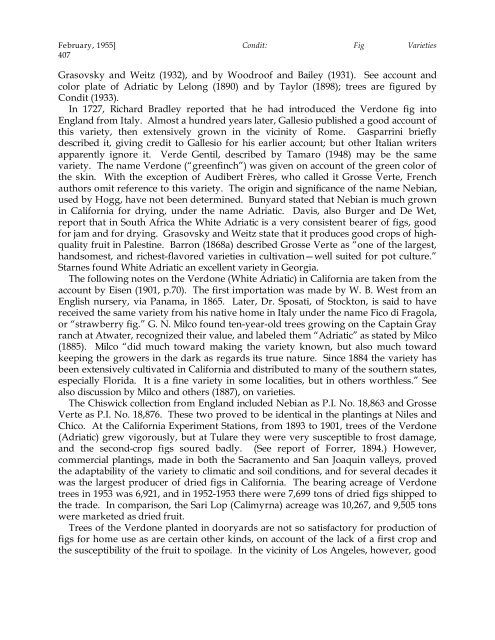Fig Varieties: A Monograph - uri=ucce.ucdavis
Fig Varieties: A Monograph - uri=ucce.ucdavis
Fig Varieties: A Monograph - uri=ucce.ucdavis
You also want an ePaper? Increase the reach of your titles
YUMPU automatically turns print PDFs into web optimized ePapers that Google loves.
February, 1955] Condit: <strong>Fig</strong> <strong>Varieties</strong><br />
407<br />
Grasovsky and Weitz (1932), and by Woodroof and Bailey (1931). See account and<br />
color plate of Adriatic by Lelong (1890) and by Taylor (1898); trees are figured by<br />
Condit (1933).<br />
In 1727, Richard Bradley reported that he had introduced the Verdone fig into<br />
England from Italy. Almost a hundred years later, Gallesio published a good account of<br />
this variety, then extensively grown in the vicinity of Rome. Gasparrini briefly<br />
described it, giving credit to Gallesio for his earlier account; but other Italian writers<br />
apparently ignore it. Verde Gentil, described by Tamaro (1948) may be the same<br />
variety. The name Verdone (“greenfinch”) was given on account of the green color of<br />
the skin. With the exception of Audibert Frères, who called it Grosse Verte, French<br />
authors omit reference to this variety. The origin and significance of the name Nebian,<br />
used by Hogg, have not been determined. Bunyard stated that Nebian is much grown<br />
in California for drying, under the name Adriatic. Davis, also Burger and De Wet,<br />
report that in South Africa the White Adriatic is a very consistent bearer of figs, good<br />
for jam and for drying. Grasovsky and Weitz state that it produces good crops of highquality<br />
fruit in Palestine. Barron (1868a) described Grosse Verte as “one of the largest,<br />
handsomest, and richest-flavored varieties in cultivation—well suited for pot culture.”<br />
Starnes found White Adriatic an excellent variety in Georgia.<br />
The following notes on the Verdone (White Adriatic) in California are taken from the<br />
account by Eisen (1901, p.70). The first importation was made by W. B. West from an<br />
English nursery, via Panama, in 1865. Later, Dr. Sposati, of Stockton, is said to have<br />
received the same variety from his native home in Italy under the name Fico di Fragola,<br />
or “strawberry fig.” G. N. Milco found ten-year-old trees growing on the Captain Gray<br />
ranch at Atwater, recognized their value, and labeled them “Adriatic” as stated by Milco<br />
(1885). Milco “did much toward making the variety known, but also much toward<br />
keeping the growers in the dark as regards its true nature. Since 1884 the variety has<br />
been extensively cultivated in California and distributed to many of the southern states,<br />
especially Florida. It is a fine variety in some localities, but in others worthless.” See<br />
also discussion by Milco and others (1887), on varieties.<br />
The Chiswick collection from England included Nebian as P.I. No. 18,863 and Grosse<br />
Verte as P.I. No. 18,876. These two proved to be identical in the plantings at Niles and<br />
Chico. At the California Experiment Stations, from 1893 to 1901, trees of the Verdone<br />
(Adriatic) grew vigorously, but at Tulare they were very susceptible to frost damage,<br />
and the second-crop figs soured badly. (See report of Forrer, 1894.) However,<br />
commercial plantings, made in both the Sacramento and San Joaquin valleys, proved<br />
the adaptability of the variety to climatic and soil conditions, and for several decades it<br />
was the largest producer of dried figs in California. The bearing acreage of Verdone<br />
trees in 1953 was 6,921, and in 1952-1953 there were 7,699 tons of dried figs shipped to<br />
the trade. In comparison, the Sari Lop (Calimyrna) acreage was 10,267, and 9,505 tons<br />
were marketed as dried fruit.<br />
Trees of the Verdone planted in dooryards are not so satisfactory for production of<br />
figs for home use as are certain other kinds, on account of the lack of a first crop and<br />
the susceptibility of the fruit to spoilage. In the vicinity of Los Angeles, however, good















![Fig Trees in North Carolina [Archive] - IDigMyGarden ... - Figs 4 Fun](https://img.yumpu.com/26905320/1/190x245/fig-trees-in-north-carolina-archive-idigmygarden-figs-4-fun.jpg?quality=85)
